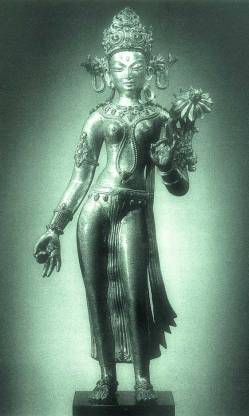“A religion without a Goddess is halfway to atheism.”
Dion Fortune

As I ponder Earth Day my mind and heart are drawn to a contemplation of the Divine Feminine. I experience Earth as a goddess, as a mother, and my love for her is deep. I was drawn to this image of Green Tara, a goddess in the Buddhist and Hindu traditions. Within Tibetan Buddhism Tara is regarded as a bodhisattva of compassion in action and came to be seen as an expression of perfected wisdom. Green Tara and White Tara are the most popular representations of Tara.
Tara embodies many of the qualities of the feminine principle. She is known as the Mother of Mercy and Compassion. She is the source, the female aspect of the universe, which gives birth to warmth, compassion, and relief from bad karma as experienced by ordinary beings in cyclic existence. She engenders, nourishes, smiles at the vitality of creation, and has sympathy for all beings as a mother does for her children. Green Tara offers help and protection from all the unfortunate circumstances one can encounter within the world of sorrow. As White Tara she expresses maternal compassion and offers healing to beings who are hurt or wounded, either mentally or psychically.
Nearly forty thousand years ago a Great Goddess was revered, and clay figures of her are the earliest depictions of humans that have been found. Cultures were more agricultural, time was experienced as circular, and the growing cycles of Earth were honored. Seasonal festivals celebrated the annual ebb and flow of life as people moved in conscious resonance with shifting cycles of light and dark, life and death. Western culture no longer moves in harmony with natural cycles. In fact, we can no longer see the stars. Earth Day celebrations bring back the honoring of the Earth and her cycles.
I believe humanity has a deep need to revere the feminine side of the divine. This unmet need is surfacing in our time in such examples as the phenomenal popularity of The Da Vinci Code, which highlighted principles of the feminine. Apparitions of Mary, mother of Jesus, are on the rise around the world. One of the most documented in recent times was in Zeitoun, Egypt, where hundreds of thousands of people of diverse beliefs stood side by side, over a period of twenty-three years, watching as Mary appeared over a small church in a suburb of Cairo. Millions make annual pilgrimages to Fatima, Lourdes, and the site of Our Lady of Guadalupe in Mexico. Worldwide response to the death of beloved Princess Diana of Wales also spoke to our need to revere a feminine archetype.
The feminine is half of all that exists. At this time I especially honor the feminine principle that is the Earth as well as all the growing things.
Give someone you love a gift of 366 goddess for Earth Day or Mother’s Day. Click on the book to order.
My deepest thanks.
Julie



